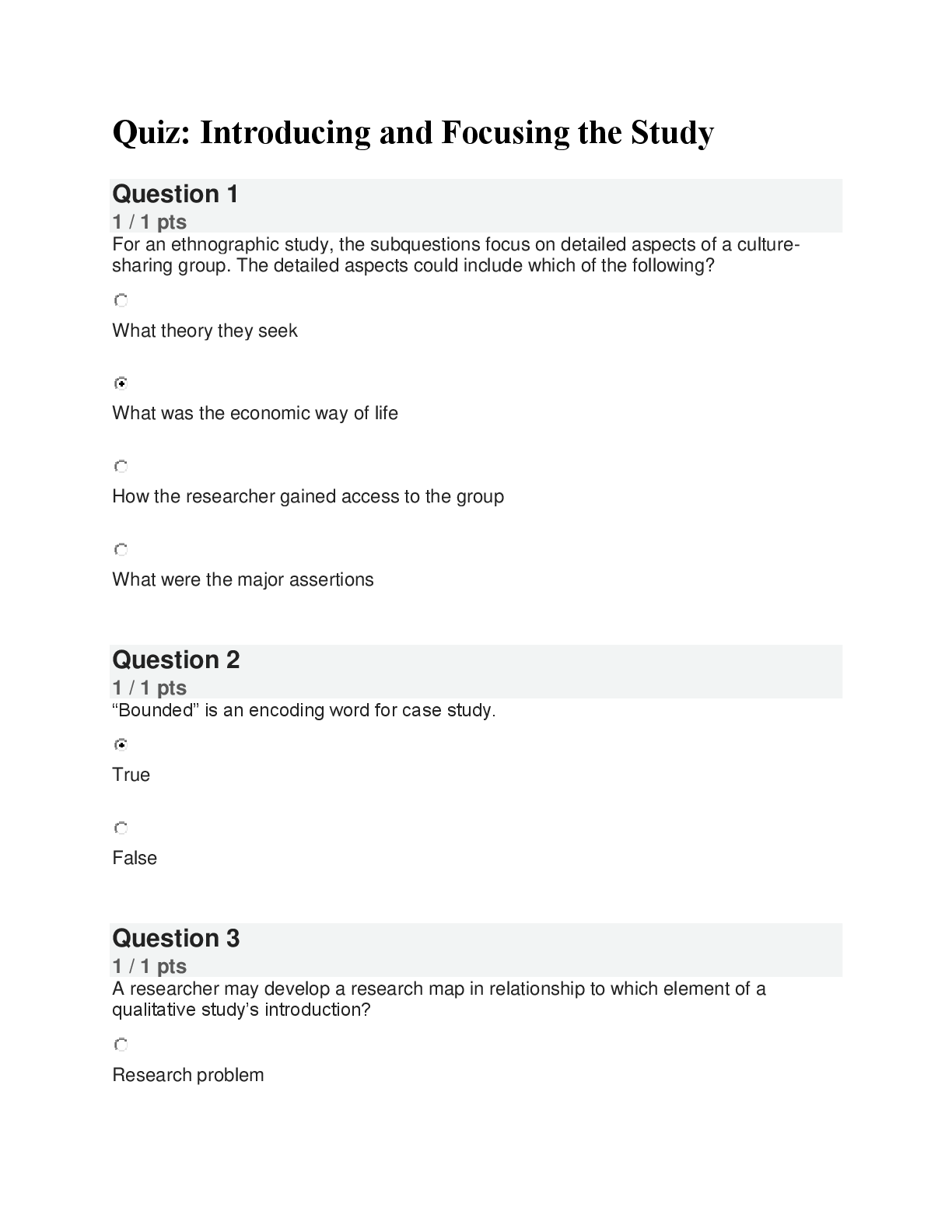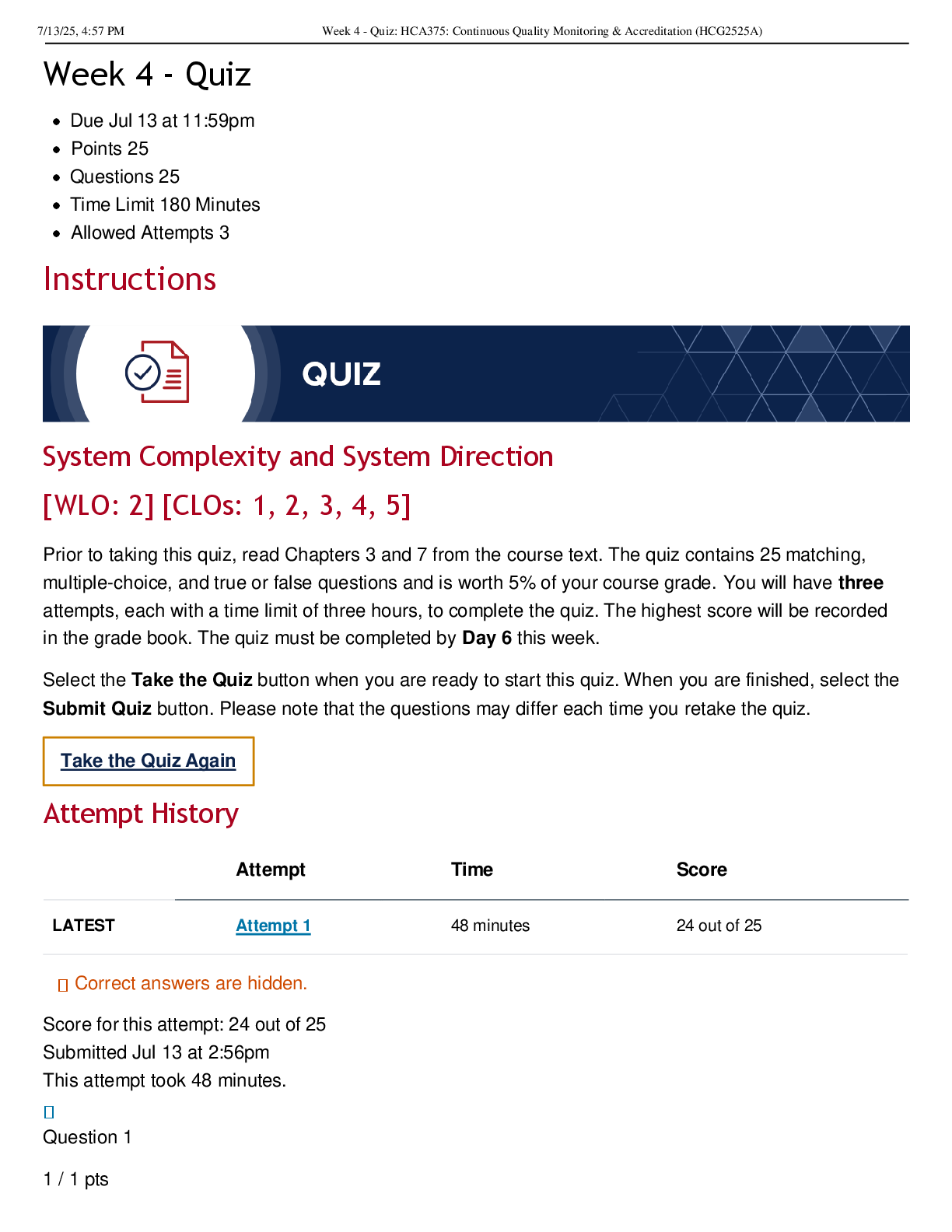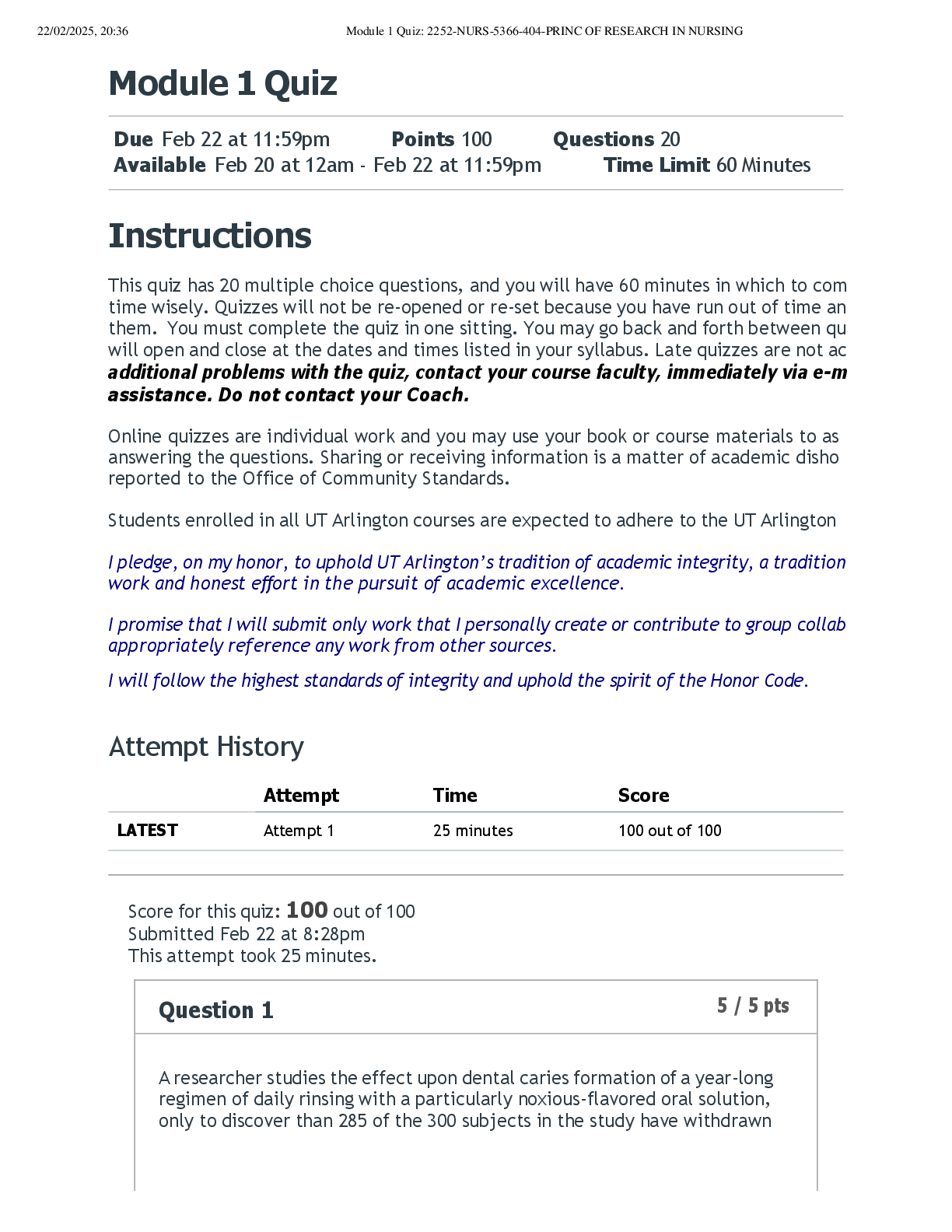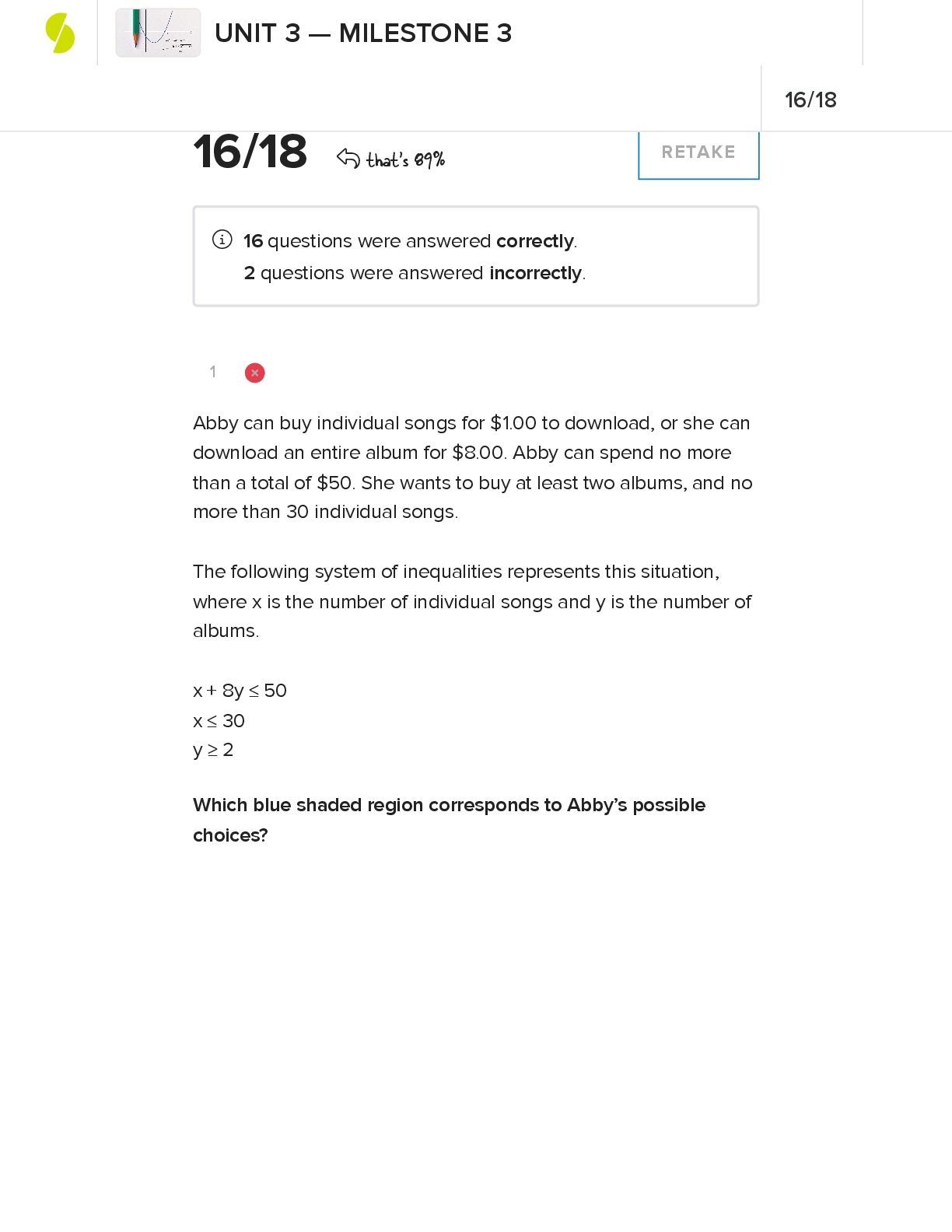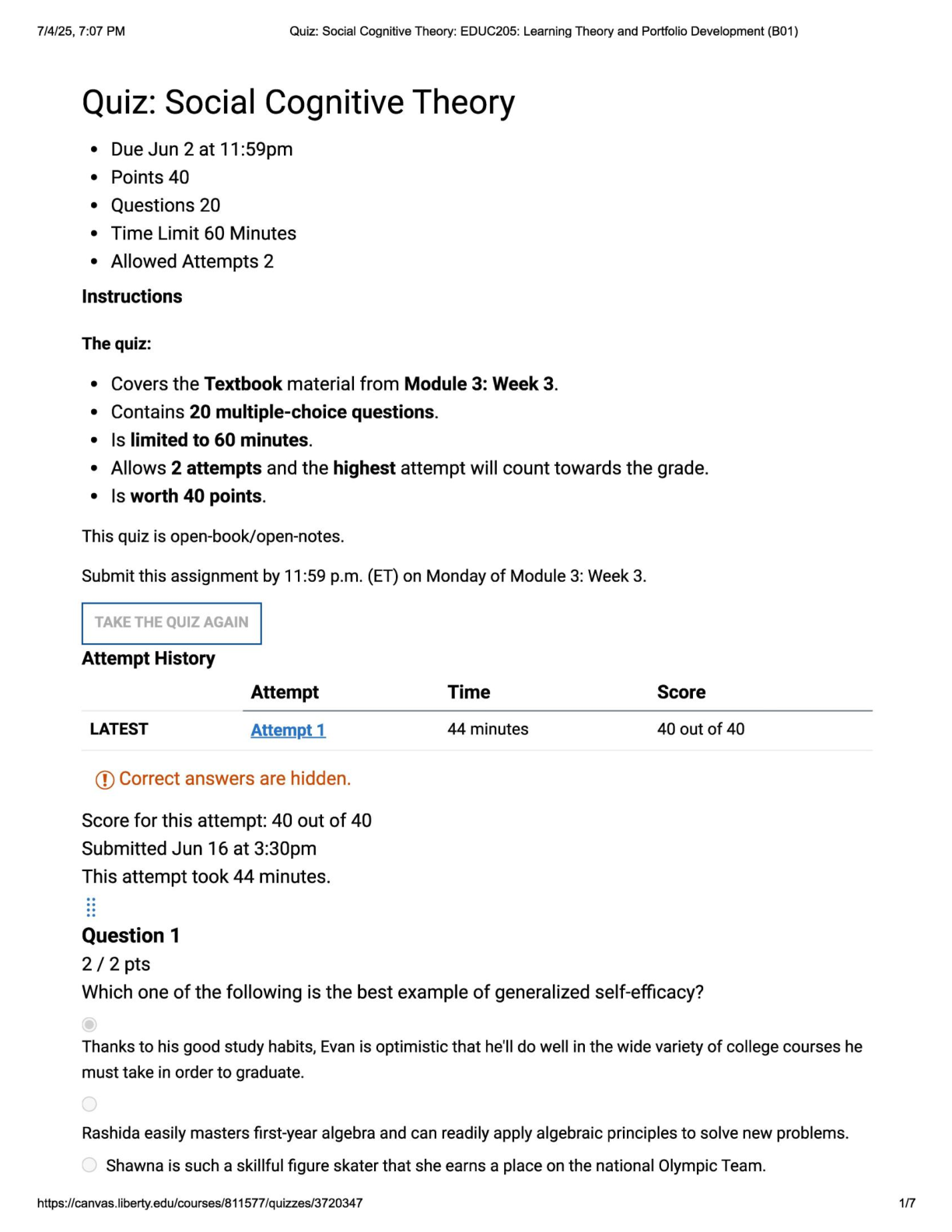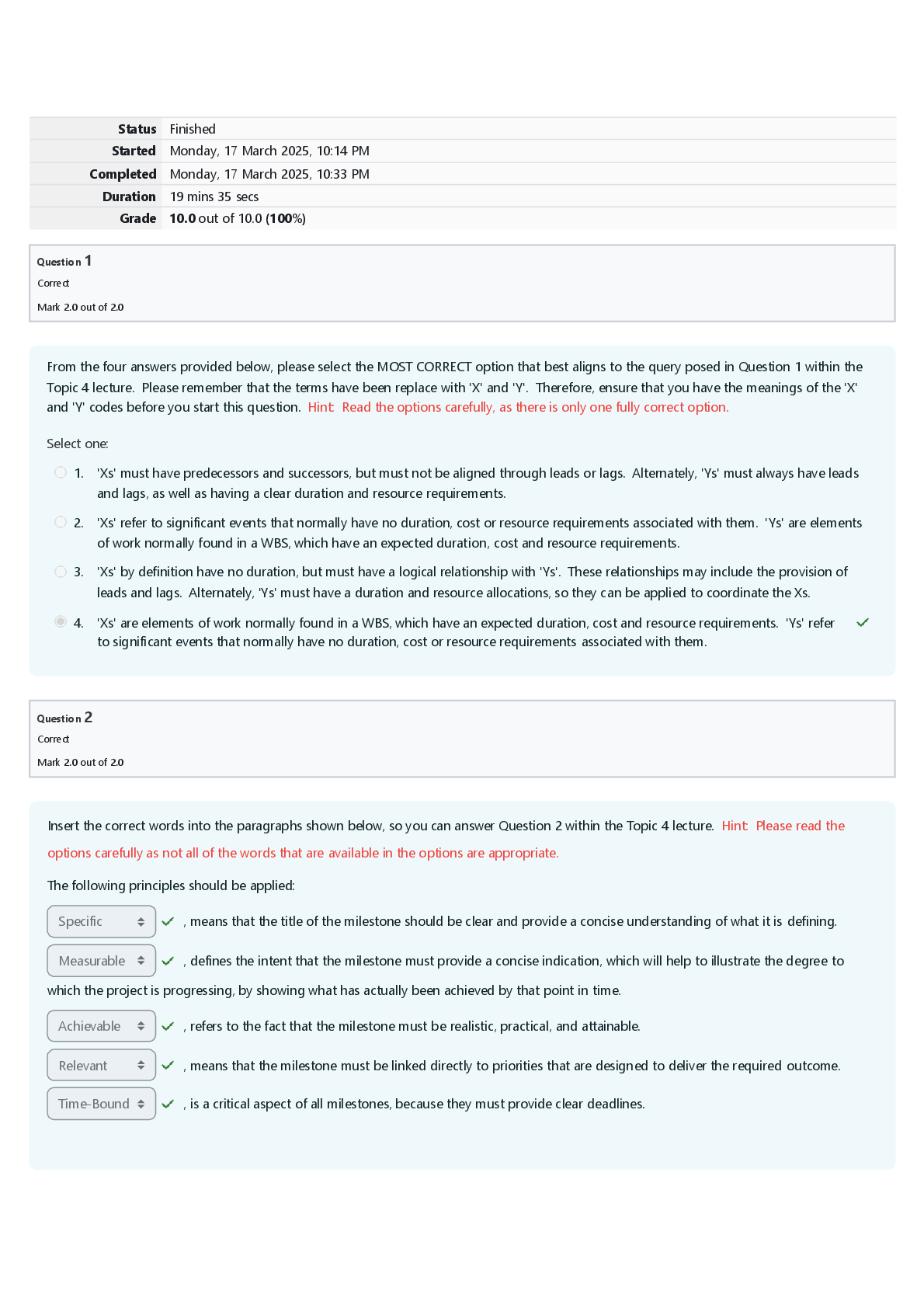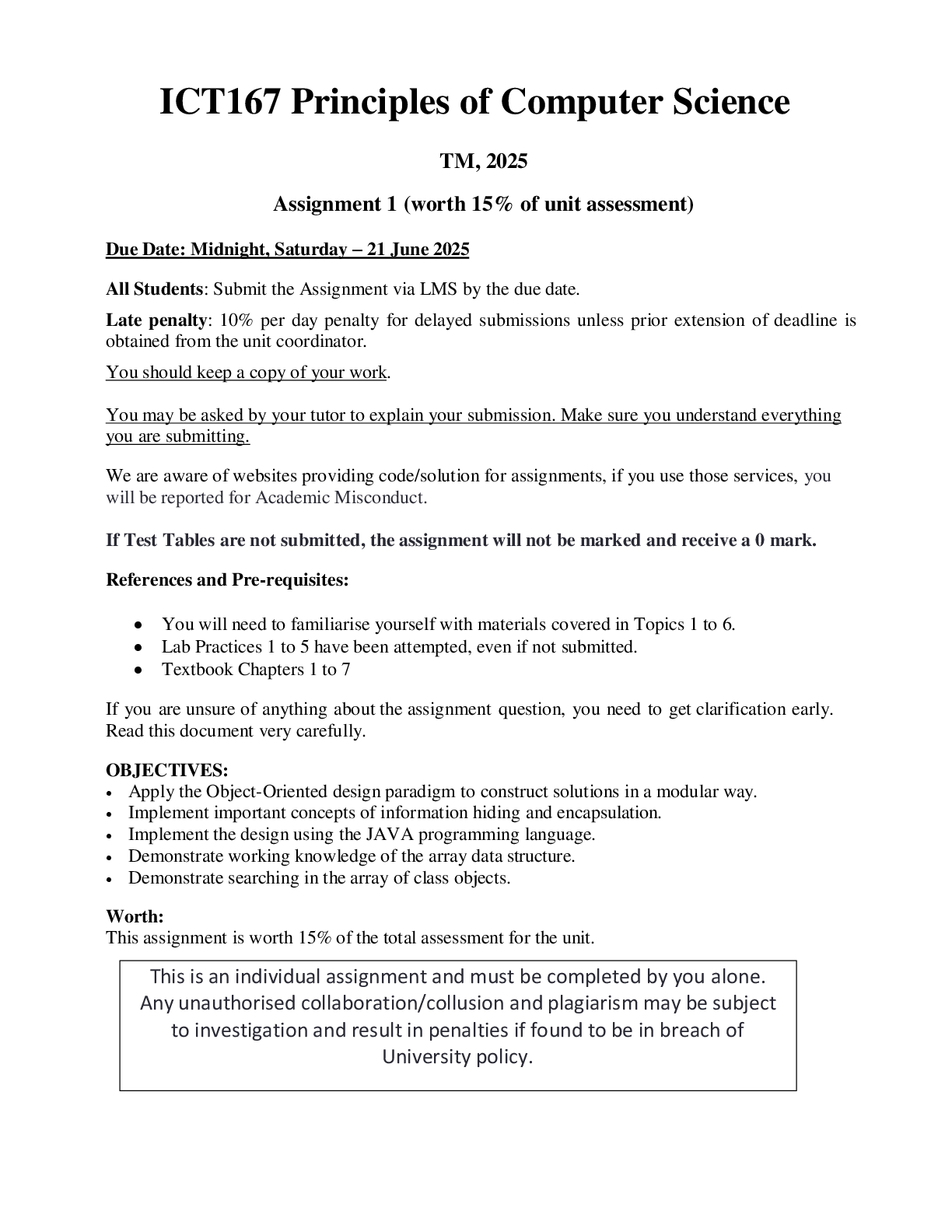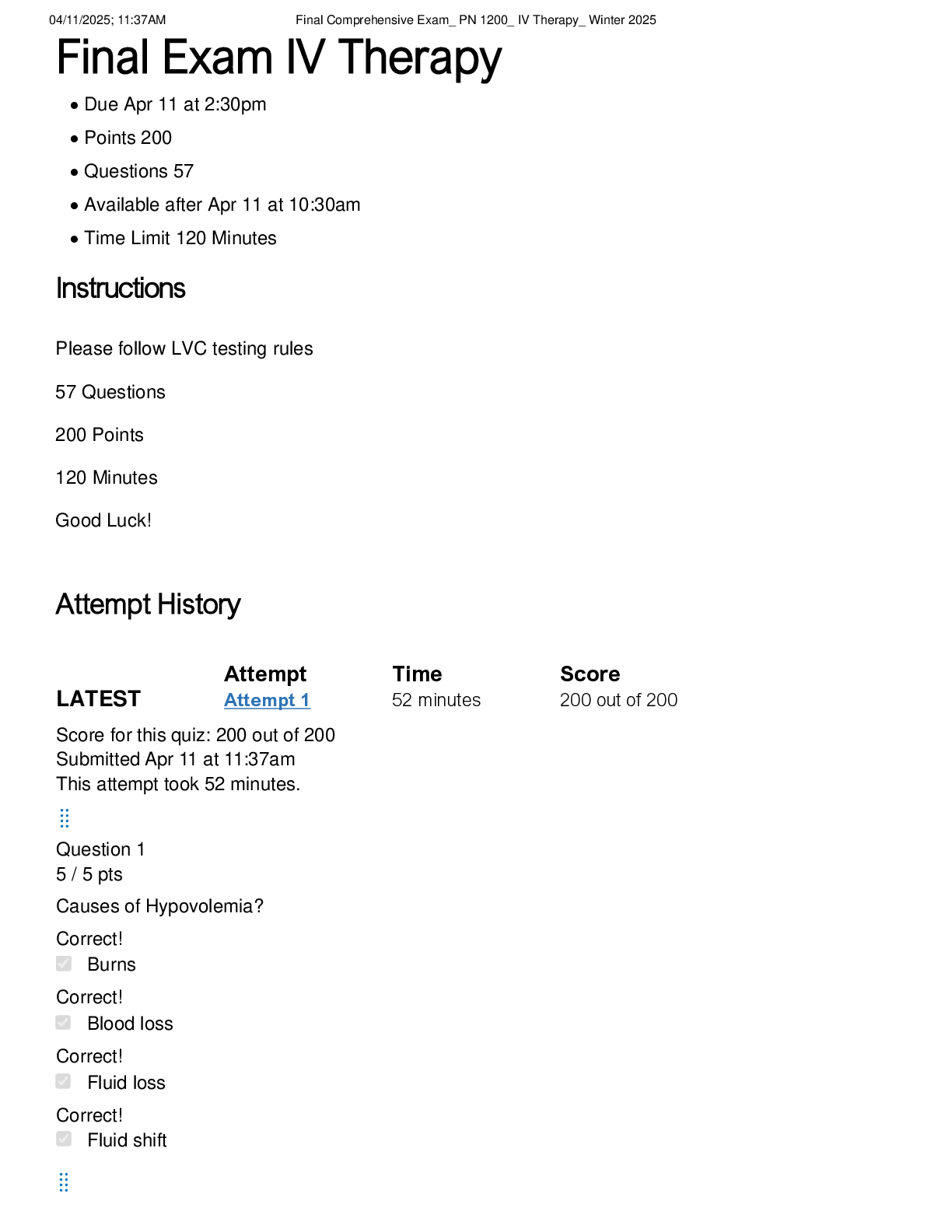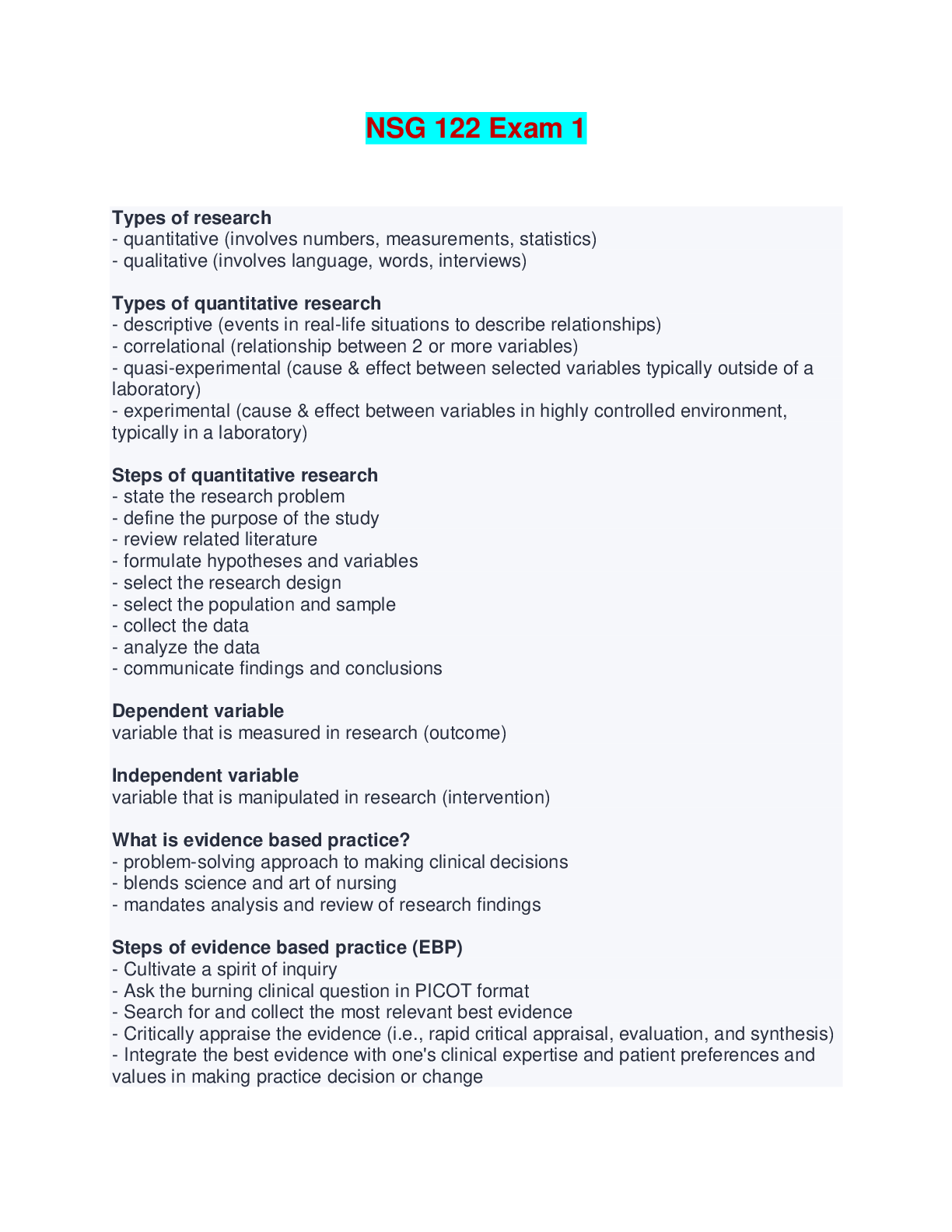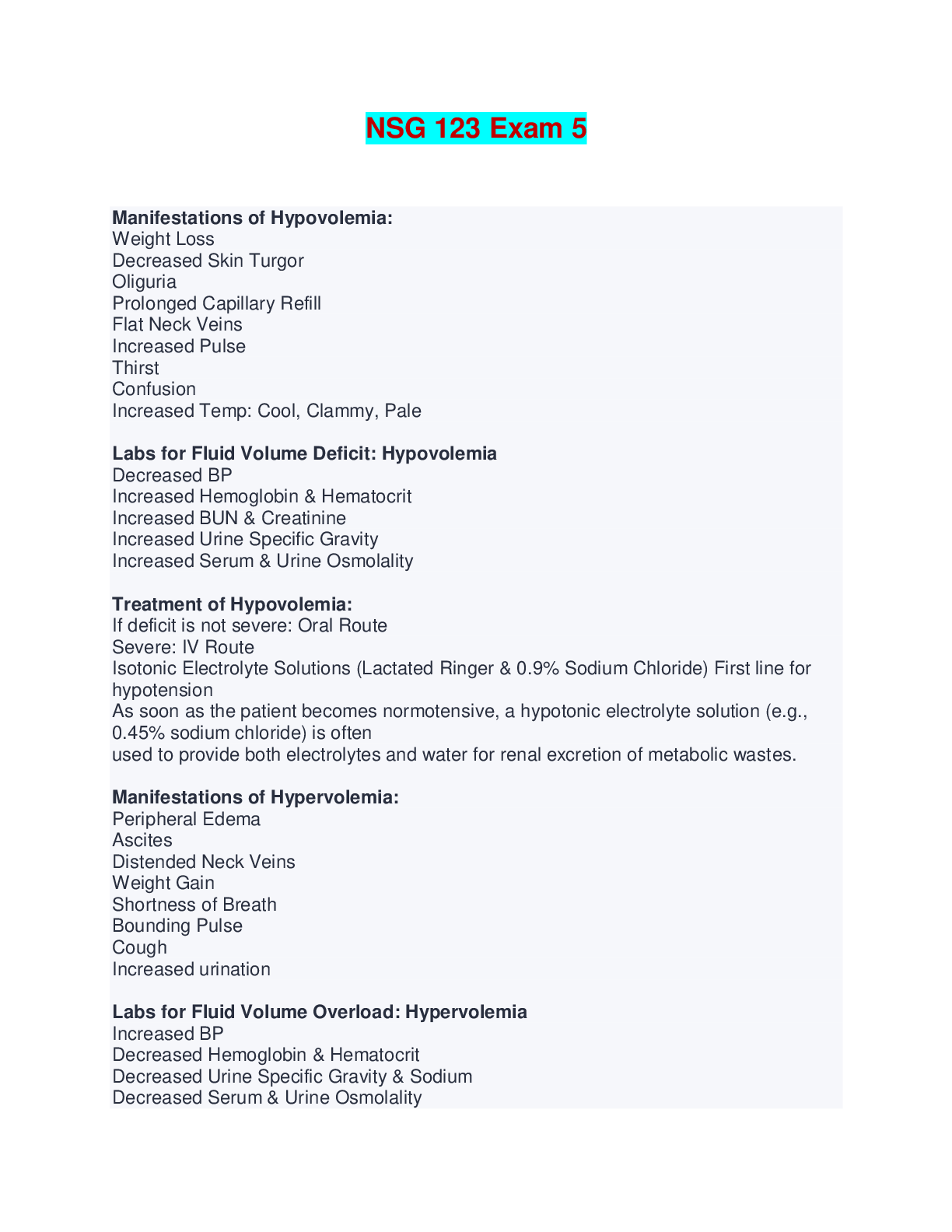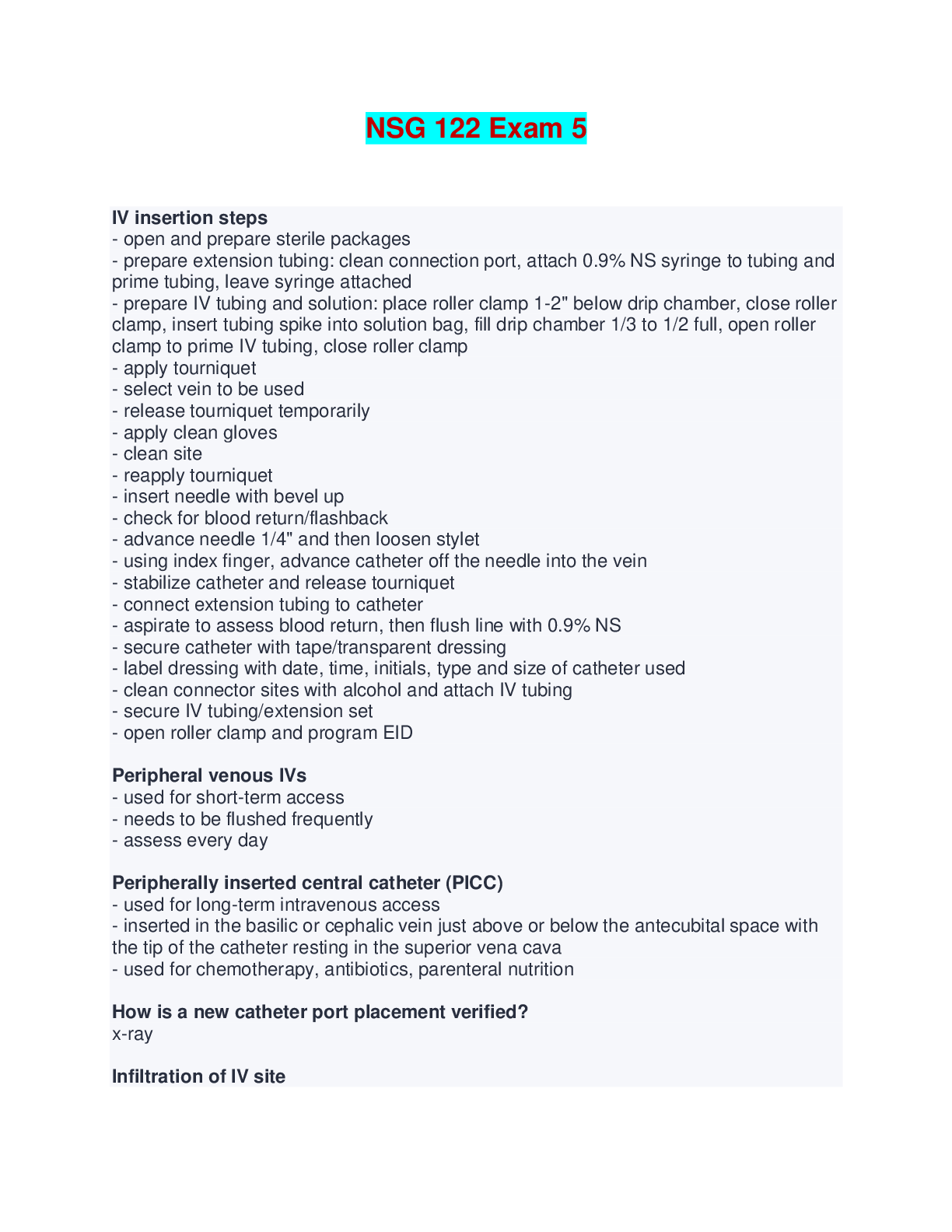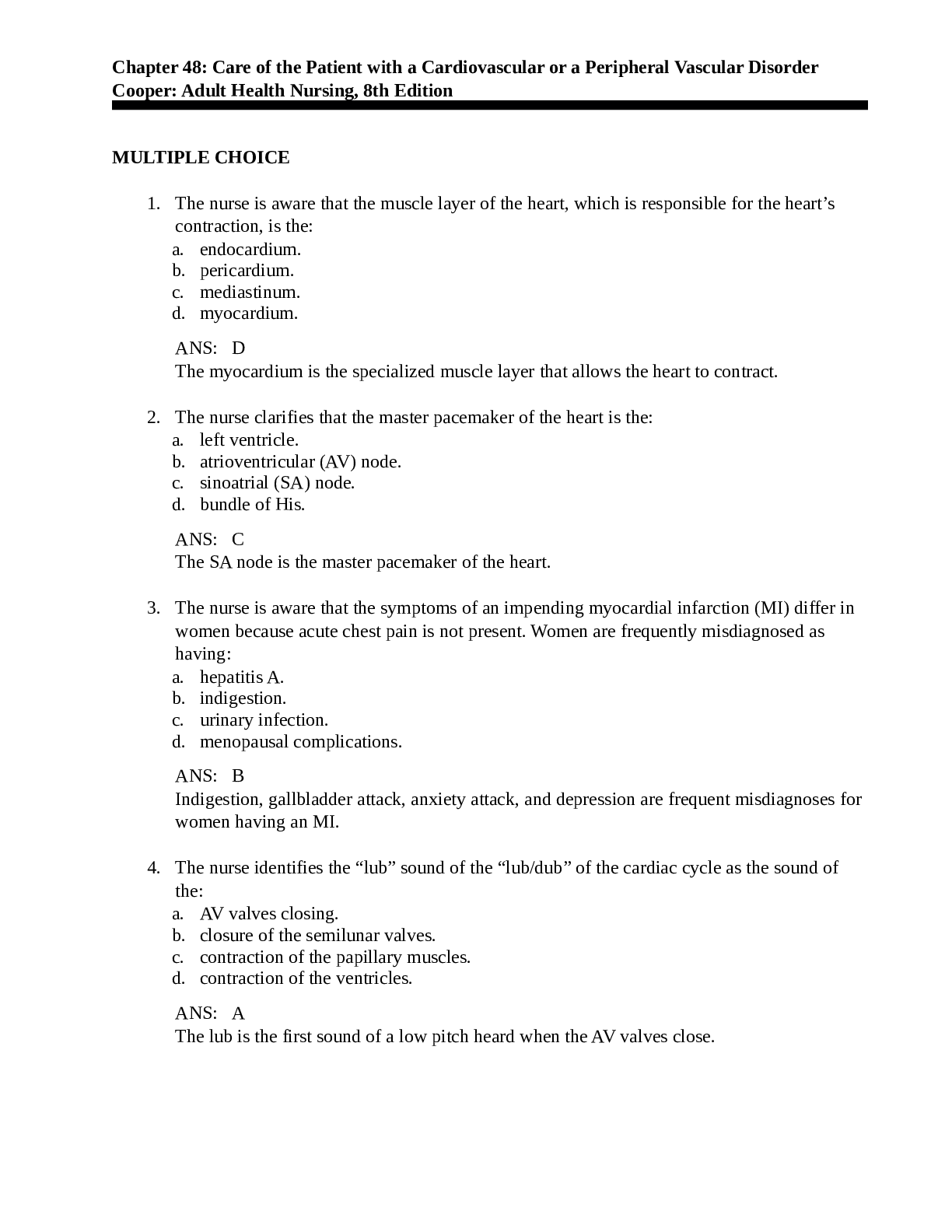PEDIATRIC NURSING > EXAM > Exam 2 (Peds) Chapter 42 – The Child with a Cardiovascular Dysfunction | With Verified Answers (All)
Exam 2 (Peds) Chapter 42 – The Child with a Cardiovascular Dysfunction | With Verified Answers
Document Content and Description Below
Exam 2 (Peds) Chapter 42 – The Child with a Cardiovascular Dysfunction | With Verified Answers Which complication should the nurse assess for when caring for a child post cardiac catheterization? ... a. Cardiac arrhythmia b. Hypostatic pneumonia c. Congestive heart failure d. Rapidly increasing blood pressure Jose is 4 year old. Preoperative teaching for a 4-year-old child scheduled for a cardiac catheterization should be done with what primary consideration in mind? a. Directed at his parents because he is too young to understand. b. Detailed in regard to the actual procedures so he will know what to expect. c. Done several days before the procedure so that he will be prepared. d. Adapted to his level of development so that he can understand. The nurse is caring for a school-age girl who has had a cardiac catheterization. The child tells the nurse that her bandage is -too wet. The nurse finds the bandage and bed soaked with blood. What is the most appropriate initial nursing action? a. Notify the physician. b. Apply a new bandage with more pressure. c. Place the child in the Trendelenburg position. d. Apply direct pressure above the catheterization site. Which defect results in increased pulmonary blood flow? a. Pulmonic stenosis b. Tricuspid atresia c. Atrial septal defect d. Transposition of the great arteries Which structural defects constitute tetralogy of Fallot? a. Pulmonic stenosis, ventricular septal defect, overriding aorta, right ventricular hypertrophy b. Aortic stenosis, ventricular septal defect, overriding aorta, right ventricular hypertrophy c. Aortic stenosis, atrial septal defect, overriding aorta, left ventricular hypertrophy d. Pulmonic stenosis, ventricular septal defect, aortic hypertrophy, left ventricular hypertrophy What is best described as the inability of the heart to pump an adequate amount of blood to the systemic circulation at normal filling pressures? a. Pulmonary congestion b. Congenital heart defect c. Congestive heart failure d. Systemic venous congestion A clinical manifestation of the systemic venous congestion that can occur with congestive heart failure is: a. Tachypnea. b. Tachycardia. c. Peripheral edema. d. Pale, cool extremities. A beneficial effect of administering digoxin (Lanoxin) is that it: a. Decreases edema. b. Decreases cardiac output. c. Increases heart size. d. Increases venous pressure. Which drug is an angiotensin-converting enzyme (ACE) inhibitor? a. Captopril (Capoten) b. Furosemide (Lasix) c. Spironolactone (Aldactone) d. Chlorothiazide (Diuril) The nurse is evaluating a child who is taking digoxin for her cardiac condition. The nurse is cognizant that a common sign of digoxin toxicity is: a. Seizures. b. Vomiting. c. Bradypnea. d. Tachycardia. The parents of a young child with congestive heart failure tell the nurse that they are "nervous" about giving digoxin. The nurse's response should be based on knowing that: a. It is a safe, frequently used drug. b. It is difficult to either overmedicate or undermedicate with digoxin. c. Parents lack the expertise necessary to administer digoxin. d. Parents must learn specific, important guidelines for administration of digoxin. As part of the treatment for congestive heart failure, the child takes the diuretic furosemide. As part of teaching home care, the nurse encourages the family to give the child foods such as bananas, oranges, and leafy vegetables. These foods are recommended because they are high in: a. Chlorides. b. Potassium. c. Sodium. d. Vitamins. An 8-month-old infant has a hypercyanotic spell while blood is being drawn. The nurse's first action should be to: a. Assess for neurologic defects. b. Place the child in the knee-chest position. c. Begin cardiopulmonary resuscitation. d. Prepare the family for imminent death. The nurse is caring for a child with persistent hypoxia secondary to a cardiac defect. The nurse recognizes that a risk of cerebrovascular accidents (strokes) exists. An important objective to decrease this risk is to: a. Minimize seizures. b. Prevent dehydration. c. Promote cardiac output. d. Reduce energy expenditure. Parents of a 3-year-old child with congenital heart disease are afraid to let their child play with other children because of possible overexertion. The nurse's reply should be based on knowing that: a. The child needs opportunities to play with peers. b. The child needs to understand that peers' activities are too strenuous. c. Parents can meet all the child's needs. d. Constant parental supervision is needed to avoid overexertion. When preparing a school-age child and the family for heart surgery, the nurse should consider: a. Not showing unfamiliar equipment. b. Letting child hear the sounds of an electrocardiograph monitor. c. Avoiding mentioning postoperative discomfort and interventions. d. Explaining that an endotracheal tube will not be needed if the surgery goes well. Seventy-two hours after cardiac surgery, a young child has a temperature of 37.7 C (101 F). The nurse should: a. Keep the child warm with blankets. b. Apply a hypothermia blanket. c. Record the temperature on nurses' notes. d. Report findings to physician. An important nursing consideration when suctioning a young child who has had heart surgery is to: a. Perform suctioning at least every hour. b. Suction for no longer than 30 seconds at a time. c. Administer supplemental oxygen before and after suctioning. d. Expect symptoms of respiratory distress when suctioning. The nurse is caring for a child after heart surgery. What should she or he do if evidence is found of cardiac tamponade? a. Increase analgesia. b. Apply warming blankets. c. Immediately report this to the physician. d. Encourage the child to cough, turn, and breathe deeply. An important nursing consideration when chest tubes will be removed from a child is to: a. Explain that it is not painful. b. Explain that only a Band-Aid will be needed. c. Administer analgesics before the procedure. d. Expect bright red drainage for several hours after removal. The most common causative agent of bacterial endocarditis is: a. Staphylococcus albus. b. Streptococcus hemolyticus. c. Staphylococcus albicans. d. Streptococcus viridans. Which painful, tender, pea-sized nodules may appear on the pads of the fingers or toes in bacterial endocarditis? a. Osler's nodes b. Janeway lesions c. Subcutaneous nodules d. Aschoff's nodules The primary nursing intervention necessary to prevent bacterial endocarditis is to: a. Institute measures to prevent dental procedures. b. Counsel parents of high risk children about prophylactic antibiotics. c. Observe children for complications such as embolism and heart failure. d. Encourage restricted mobility in susceptible children. A common, serious complication of rheumatic fever is: a. Seizures. b. Cardiac arrhythmias. c. Pulmonary hypertension. d. Cardiac valve damage. A major clinical manifestation of rheumatic fever is: a. Polyarthritis. b. Osler's nodes. c. Janeway spots. d. Splinter hemorrhages of distal third of nails. When discussing hyperlipidemia with a group of adolescents, the nurse should explain that high levels of what substance are thought to protect against cardiovascular disease? a. Cholesterol b. Triglycerides c. Low-density lipoproteins (LDLs) d. High-density lipoproteins (HDLs). The leading cause of death after heart transplantation is: a. Infection. b. Rejection. c. Cardiomyopathy. d. Congestive heart failure. When caring for the child with Kawasaki disease, the nurse should understand that: a. The child's fever is usually responsive to antibiotics within 48 hours. b. The principal area of involvement is the joints. c. Aspirin is contraindicated. d. Therapeutic management includes administration of gamma globulin and aspirin. One of the most frequent causes of hypovolemic shock in children is: a. Myocardial infarction. b. Blood loss. c. Anaphylaxis. d. Congenital heart disease. What type of shock is characterized by a hypersensitivity reaction causing massive vasodilation and capillary leaks, which may occur with drug or latex allergy? a. Neurogenic shock b. Cardiogenic shock c. Hypovolemic shock d. Anaphylactic shock Which clinical changes occur as a result of septic shock? a. Hypothermia b. Increased cardiac output c. Vasoconstriction d. Angioneurotic edema A child is brought to the emergency department experiencing an anaphylactic reaction to a bee sting. While an airway is being established, what medication should the nurse prepare for immediate administration? a. Diphenhydramine (Benadryl) b. Dopamine c. Epinephrine d. Calcium chloride Which postoperative intervention should be questioned for a child after a cardiac catheterization? a. Continue intravenous (IV) fluids until the infant is tolerating oral fluids. b. Check the dressing for bleeding. c. Assess peripheral circulation on the affected extremity. d. Keep the affected leg flexed and elevated. In which situation is there the greatest risk that a newborn infant will have a congenital heart defect (CHD)? a. Trisomy 21 detected on amniocentesis b. Family history of myocardial infarction c. Father has type 1 diabetes mellitus d. Older sibling born with Turner's syndrome Which intervention should be included in the plan of care for an infant with the nursing diagnosis of Excess Fluid Volume related to congestive heart failure? a. Weigh the infant every day on the same scale at the same time. b. Notify the physician when weight gain exceeds more than 20 g/day. c. Put the infant in a car seat to minimize movement. d. Administer digoxin (Lanoxin) as ordered by the physician. The nurse assessing a premature newborn infant auscultates a continuous machinery-like murmur. This finding is associated with which congenital heart defect? a. Pulmonary stenosis b. Patent ductus arteriosus c. Ventricular septal defect d. Coarctation of the aorta What is an expected assessment finding in a child with coarctation of the aorta? a. Orthostatic hypotension b. Systolic hypertension in the lower extremities c. Blood pressure higher on the left side of the body d. Disparity in blood pressure between the upper and lower extremities A child with pulmonary atresia exhibits cyanosis with feeding. On reviewing this child's laboratory values, the nurse is not surprised to notice which abnormality? a. Polycythemia b. Infection c. Dehydration d. Anemia When assessing a child for possible congenital heart defects (CHDs), where should the nurse measure blood pressure? a. The right arm b. The left arm c. All four extremities d. Both arms while the child is crying What is the nurse's first action when planning to teach the parents of an infant with a congenital heart defect (CHD)? a. Assess the parents' anxiety level and readiness to learn. b. Gather literature for the parents. c. Secure a quiet place for teaching. d. Discuss the plan with the nursing team For what reason might a newborn infant with a cardiac defect, such as coarctation of the aorta, that results in a right-to-left shunt receive prostaglandin E1? a. To decrease inflammation b. To control pain c. To decrease respirations d. To improve oxygenation What is the appropriate priority nursing action for the infant with a CHD who has an increased respiratory rate, is sweating, and is not feeding well? a. Recheck the infant's blood pressure. b. Alert the physician. c. Withhold oral feeding. d. Increase the oxygen rate. A nurse is teaching an adolescent about primary hypertension. The nurse knows that which of the following is correct? a. Primary hypertension should be treated with diuretics as soon as it is detected. b. Congenital heart defects are the most common cause of primary hypertension. c. Primary hypertension may be treated with weight reduction. d. Primary hypertension is not affected by exercise. An adolescent being seen by the nurse practitioner for a sports physical is identified as having hypertension. On further testing, it is discovered the child has a cardiac abnormality. The initial treatment of secondary hypertension initially involves: a. Weight control and diet. b. Treating the underlying disease. c. Administration of digoxin. d. Administration of -adrenergic receptor blockers. The nurse is preparing an adolescent for discharge after a cardiac catheterization. Which statement by the adolescent would indicate a need for further teaching? a. "I should avoid tub baths but may shower." b. "I have to stay on strict bed rest for 3 days." c. "I should remove the pressure dressing the day after the procedure." d. "I may attend school but should avoid exercise for several days." Surgical closure of the ductus arteriosus would: a. Stop the loss of unoxygenated blood to the systemic circulation. b. Decrease the edema in legs and feet. c. Increase the oxygenation of blood. d. Prevent the return of oxygenated blood to the lungs. A nurse is teaching nursing students the physiology of congenital heart defects. Which defect results in decreased pulmonary blood flow? a. Atrial septal defect b. Tetralogy of Fallot c. Ventricular septal defect d. Patent ductus arteriosus The nurse is talking to a parent of an infant with heart failure about feeding the infant. Which statement about feeding the child is correct? a. "You may need to increase the caloric density of your infant's formula." b. "You should feed your baby every 2 hours." c. "You may need to increase the amount of formula your infant eats with each feeding." d. "You should place a nasal oxygen cannula on your infant during and after each feeding." The nurse is admitting a child with rheumatic fever. Which therapeutic management should the nurse expect to implement? a. Administering penicillin b. Avoiding salicylates (aspirin) c. Imposing strict bed rest for 4 to 6 weeks d. Administering corticosteroids if chorea develops Which action by the school nurse is important in the prevention of rheumatic fever? a. Encourage routine cholesterol screenings. b. Conduct routine blood pressure screenings. c. Refer children with sore throats for throat cultures. d. Recommend salicylates instead of acetaminophen for minor discomforts. A preschool child is scheduled for an echocardiogram. Parents ask the nurse whether they can hold the child during the procedure. The nurse should answer with which response? a. "You will be able to hold your child during the procedure." b. "Your child can be active during the procedure, but can't sit in your lap." c. "Your child must lie quietly; sometimes a mild sedative is administered before the procedure." d. "The procedure is invasive so your child will be restrained during the echocardiogram The nurse is caring for an infant with congestive heart disease (CHD). The nurse should plan which intervention to decrease cardiac demands? [Show More]
Last updated: 11 months ago
Preview 4 out of 18 pages

Loading document previews ...
Buy this document to get the full access instantly
Instant Download Access after purchase
Buy NowInstant download
We Accept:

Reviews( 0 )
$15.50
Can't find what you want? Try our AI powered Search
Document information
Connected school, study & course
About the document
Uploaded On
Aug 07, 2024
Number of pages
18
Written in
Additional information
This document has been written for:
Uploaded
Aug 07, 2024
Downloads
0
Views
56

